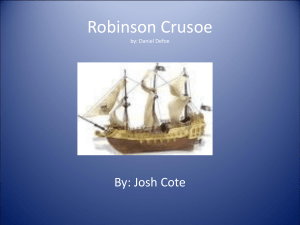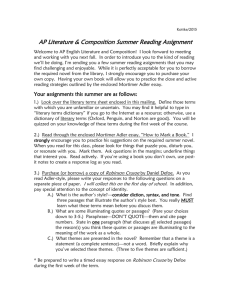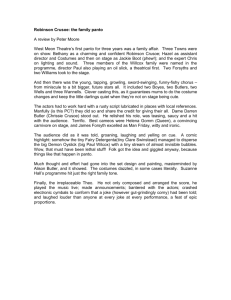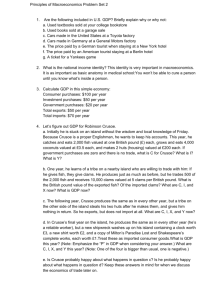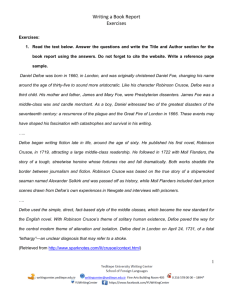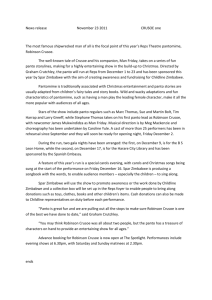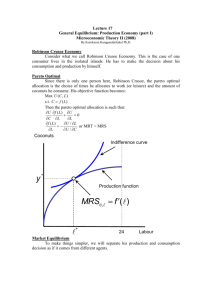Imaginary Homelands: Viagens na Minha Terra and Robinson Crusoe
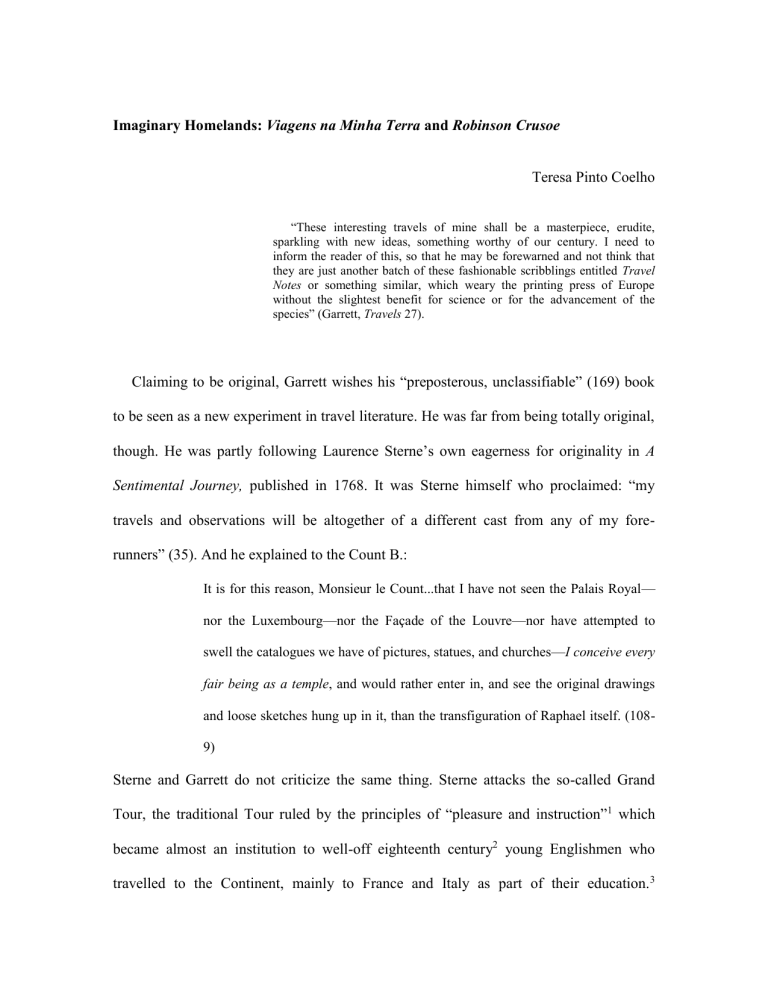
Imaginary Homelands: Viagens na Minha Terra and Robinson Crusoe
Teresa Pinto Coelho
“These interesting travels of mine shall be a masterpiece, erudite, sparkling with new ideas, something worthy of our century. I need to inform the reader of this, so that he may be forewarned and not think that they are just another batch of these fashionable scribblings entitled Travel
Notes or something similar, which weary the printing press of Europe without the slightest benefit for science or for the advancement of the species” (Garrett, Travels 27).
Claiming to be original, Garrett wishes his “preposterous, unclassifiable” (169) book to be seen as a new experiment in travel literature. He was far from being totally original, though. He was partly following Laurence Sterne’s own eagerness for originality in A
Sentimental Journey, published in 1768. It was Sterne himself who proclaimed: “my travels and observations will be altogether of a different cast from any of my forerunners” (35). And he explained to the Count B.:
It is for this reason, Monsieur le Count...that I have not seen the Palais Royal— nor the Luxembourg—nor the Façade of the Louvre—nor have attempted to swell the catalogues we have of pictures, statues, and churches— I conceive every fair being as a temple , and would rather enter in, and see the original drawings and loose sketches hung up in it, than the transfiguration of Raphael itself. (108-
9)
Sterne and Garrett do not criticize the same thing. Sterne attacks the so-called Grand
Tour, the traditional Tour ruled by the principles of “pleasure and instruction”
1
which became almost an institution to well-off eighteenth century
2
young Englishmen who travelled to the Continent, mainly to France and Italy as part of their education.
3
Accompanied by tutors, these young men visited cities and studied monuments that were thoroughly described in travel accounts of the time. These also included observations on the character and customs of the people as well as notes on a wide range of topics such as: religion, government, commerce or even the climate of foreign countries. Sterne intended to write something different.
4
Although his main character also travels in France and Italy, the adjective “sentimental,” deliberately included in the title of his novel, shows that the purpose of the book is not to describe places but emotions.
Garrett’s criticism belongs to a different time. In the 1840s European travel had already become accessible to a large number of people as the construction of railroads cut travel time and costs dramatically. The mythical times of the Grand Tour were over. The tradition of the eighteenth century travel account was replaced by the modern travel guide with its lists of sightseeing attractions and detailed description of routes, methods of transport and all sorts of practical information. Educational purposes had been replaced by travelling for its own sake.
Interestingly enough, in Viagens Garrett attacks railroads, although not for the same reasons as some of his British contemporaries who thought that they “would make it too easy for people to move around and would therefore tend to weaken social distinctions”
(Withey 98). Despite his literary innovations, Garrett is still in some ways a conservative traveller. He still describes cities and monuments as eighteenth century British “grand tourists” did, although for purposes other than pure description.
5
In fact, Viagens belongs more to the tradition of British eighteenth century travel literature than generally acknowledged. Some work has been done on the impact made on Garrett by Sterne, 6 but it would also be possible to compare Viagens to travel literature by Henry Fielding,
Jonathan Swift and Daniel Defoe, among others, all of to whom Sterne’s
A Sentimental
Journey is indebted.
This paper intends to explore the ways in which both Garrett’s Viagens na Minha
Terra and Defoe’s Robinson Crusoe (1719) make use of travel literature tradition to build imaginary homelands for political purposes. Pretending to respect the rules of real travel accounts, the narrator of Viagens sets the date and explains the aims of his travels: “It is the 17th of the month of July, in this year of grace 1843, a Monday, an ordinary day and a good beginning. St. Paul’s is striking 6 a.m. and here am I walking to Terreiro do Paço”
(Garrett, Travels 22). And: “I shall go to Santarém, no less, and I swear that everything I see and hear, I think and feel, shall be chronicled” (22).
He never leaves his room,
7
though. Going to Santarém is just a pretext for a mental and symbolic 8 trip to one of the sceneries of the Civil War. Moreover, it allows Garrett not only to travel in space but also in time (twenty-five-and-a-half chapters out of fortynine are set in 1832-34) thus manipulating time and his readers at his own will. Also in
Robinson Crusoe , Defoe travels through Crusoe (who accumulates the roles of main character and narrator) an adventurer, the quintessential traveller, as the original version of his family name, Kreutznaer —meaning traveller or crusader—points out (3).
As the narrator’s trip to Santarém in Viagens
, Crusoe’s adventures are also set in the past. Although the novel was published in 1719 when Defoe was already fifty-nine,
Crusoe begins his fictional twenty-eight-year life as an island castaway on 30 September
1659 and returns to England in 1687. As in Viagens, dates are carefully chosen and bear an historical and political meaning. Crusoe returns home just before the Glorious
Revolution of 1688 by which the Stuarts were deposed (as Carlos comes back to Portugal
during the last stages of the Civil War), a moment Defoe saw as a turning point in his own and England’s history, having himself engaged in radical and dangerous activities to hasten the departure of the Stuarts.
9
Although it has led to a wide range of interpretations, religious and economic, among others,
10
Crusoe’s island may be seen as a narrative invitation to an alternative to Defoe’s
England, which he saw dominated by tyranny. In the tradition of utopia,
11
Crusoe creates his own island, an ideal world, away from his homeland, also an island. Both islands are kingdoms. But whereas throughout Crusoe’s adventures England is ruled by Charles II
(1600-1685) and James II (1685-1688), Crusoe becomes the king of his newly created realm. He also starts enjoying his new life, namely solitude, and sees the advantages of living far away from society: “In the first Place, I was remov’d from all the wickedness of the World here. I had neither the Lust of the Flesh, the Lust of the Eye, or the Pride of
Life, I had nothing to covet; for I had all that I was now capable of enjoying” (Defoe
128). His island becomes the image of Paradise. On his wanderings around the island
Crusoe finds a beautiful fruitful valley with melons and grapes in plenty. He writes:
When I came Home from this Journey, I contemplated with great Pleasure the
Fruitfulness of that Valley, and the Pleasantness of the Scituation, the Security from Storms on that Side, the Water and the Wood, and concluded, that I had pitch’d upon a Place to fix my Abode, which was by far the worst Part of the
County. Upon the whole I began to consider of removing my Habitation; and to look out for a Place equally safe, as where I now was scituate, if possible, in that
Part of the Island. (101)
It was this ideal existence together with Crusoe’s self-help that attracted Rousseau to
Robinson Crusoe . In fact, it was Rousseau’s reinterpretation of Defoe’s novel in Émile
(1762) that not only renewed England’s interest in
Robinson Crusoe, but also gave rise to all sorts of adaptations of the novel throughout Europe and even North America.
12
Rousseau saw in Robinson Crusoe what he wanted to see. He suppressed parts of the novel such as Crusoe’s life before arriving to and after leaving the island as well as his religious reflections. He also ignored the wreck and emphasized Crusoe’s self-help.
Crusoe survives in the island using his intelligence and manual skills. He becomes a carpenter, a baker, and a farmer and learns through observation and experience. That is why Robinson Crusoe is the first book Rousseau allowed Émile to read as a treatise on an education according to nature (Green 33-47), an idea that, as will be shown, echoes in
Viagens na Minha Terra .
Following
Émile,
the British Romantics also became enthusiastic for Defoe, namely
Walter Scott (Rogers 141-2), one of the authors Garrett knew. Wordsworth and
Coleridge, moreover, made use of traveller’s tales of adventure and descriptions of faraway places, the best known of which is, maybe, Coleridge’s “The Rime of the
Ancient Mariner”. As to the impact of Rousseau’s ideas on education on British
Romantic novels, Mary Shelley’s
Frankenstein is a good example.
13
One should not be misled by readings of Robinson Crusoe , though. On describing his valley Defoe is just following literary conventions of the time. Contemporary British
Neoclassical writers such as Pope had set the model for the depiction of landscape. A good example is the following extract from Pope’s “Windsor Forest,” a poem written in
1704 and published in its final version in 1713:
Here hills and vales, the woodland and the plain,
Here earth and water seem to strive again,
Not chaos-like together crushed and bruised,
But as the world harmoniously confused;
Where order in variety we see,
And where, though all things differ, all agree.
Here waving groves a chequered scene display,
And part admit, and part exclude the day. (21)
This kind of Happy Garden that echoes in other eighteenth-century writers who plea for a Horacian retreat from the corruption of cities and courts recurs in Robinson Crusoe .
Defoe’s island is, however, far from being a return to the pre-social existence of his species that Rousseau chose to make out of it. To the island he brings a certain model of civilization, his own. From his boat (a miniature of his original island) he rescues everything he needs: ropes, tools, guns, powder, mathematical instruments, maps, compasses, paper, ink, etc.
Moreover, Crusoe is not an innocent traveller (neither is Garrett’s narrator in
Viagens ). He not only becomes the king of the island, but also a colonizer.
14
The image of the island as a colony becomes clearer at the end of the novel and redefines the story as a political fable:
My Island was now peopled, as I thought my self very rich in Subjects; and it was a merry Reflection which I frequently made, How like a King I look’d. First of all, the whole Country was my own meer Property; so that I had an undoubted
Right of dominion. 2dly, My People were perfectly subjected: I was absolute
Lord and Law-giver; they all owned their lives to me, and were ready to lay down their lives, if there had been Occasion of it, for me. It was remarkable too, we had but three Subjects, and they were of three different Religions. My Man
Friday was a Protestant, his Father was a Pagan and a Cannibal, and the Spaniard was a Papist: However, I allow’d liberty of Conscience throughout my
Dominions. (Defoe 241)
This shows that he was a tolerant king who allowed his subjects religious freedom.
15
It is not sheer coincidence. Coming from a family of Dissenters, Defoe’s life was not easy.
He was only two years old when Charles II signed an Act of Uniformity banning nonconformists from the Anglican Church in 1662. From 1663 to 1665 the first act of the
Clarendon Code, a series of measures restricting the civil and religious rights of
Dissenters, was put into effect. Defoe’s family was barred from worship within five miles of the city walls of London. Defoe would never forget the intolerance of these days.
16
These concerns go into Robinson Crusoe, which from a story of a solitary self-sufficient island castaway becomes the prophecy of a new tolerant England coming out of Stuart hegemony and ready to embark in colonial adventures.
17
Garrett might not have read Robinson Crusoe
18 but he knew Rousseau and his
Émile
, one of the sources of his
Da Educação
(1829), well. Viagens has a lot to do with
Rousseau’s and Romantic readings of
Robinson Crusoe . From the very beginning both the heath of Cartaxo the menina dos rouxinóis’
valley are images of Paradise. A version of the pastoral is to be found in the description of the heath:
The gentle feelings aroused in the spirit by the refreshing view of a young wheatfield in the Ribatejo in early April, undulating sensuously in the mild spring breeze; the bucolic delight of a Minho cornfield at watering time, in mid-
August, when the stalks leap in the splashing water, surrounded by oak trees classically wedded to vines hung with bunches of black grapes—both scenes possess a poetry so charming and tender such as I never found translated even in
the best verses of Theocritus or Virgil, or in the most perfect prose of Gessner or
Rodigues Lobo. (Garrett, Travels 55)
As in Robinson Crusoe, the depiction of landscape bears an aesthetic and literary meaning. Garrett knows what he is doing and he does not even pretend not to: trying to show that he is neither classical nor romantic, as he himself proclaimed in the Preface to the first edition of his
Camões
(1825)
19
and in several other Prefaces to his works,
20
“at least from what the word means in today’s slang” (Garrett, Travels 56).
That is why, in the paragraph that follows, the “sombre, solemn majesty of an ancient, bosky wood, the silence and dark of its densest thickets, the solitary shelter of its clearings” (55) replace the clear shaped mid-day lighted objects described above.
As to the vale of Santarém, an image of the Garden of Eden,
21
its “perfect harmony and symmetry of colours” (64) match the symmetric structure of Pope’s landscape in the above quoted extract from “Windsor Forest”. As in Robinson Crusoe’s island, “Evil passions, petty thoughts, the burdens and base things in life can flee only far away” (64).
Although this is a false image, as shall be demonstrated, the identification of the valley with Paradise is maintained for some time, mainly through Joaninha. Carlos’s cousin has never left the valley and is the image of innocence and purity. She represents the principle of natural education as propagated in Rousseau’s
Émile
:
Natural grace and an admirable symmetry of proportion had endowd that countenance and sixteen-year-old body with all the noble elegance, all the unassuming ease of manner, all the graceful suppleness that the art, the manners and the experience of company eventually confer on a few rare and priviledged creatures in this world.
But in this case, nature had done it all, or nearly all, and education nothing, or close to nothing. (74)
Travelling to Joaninha’s valley is a return to the age of innocence forever lost by Man when expelled from Paradise. This seems to be the true itinerary of the narrator’s imaginary travels, a journey to something he has already lost. He himself, when referring to Camões, recollects with regret his age of innocence when he enjoyed “those battles, those adventures, those love-stories, all those scenes that are so natural, so well portrayed” and his “present inevitable age of experience, this prosaic age when the most beautiful creations of the human mind seem like foolish antics in the face of the real world, and the noble impulses of the heart just enthusiastic fancies” (44).
Joaninha is the symbol of that forever-lost world, an ideal utopian Portugal that does not know political factions and fraternal wars, some sort of island painted with the colours of Paradise. That utopian Portugal is not only connected to the valley but to childhood—Joaninha’s and Carlos’s. Carlos’s return to the valley is a return to those times, but only briefly, as his meeting with Joaninha shows:
They had woken with a start from that enchanted dream which had carried them to the beloved Eden of their childhood. They found themselves in a cruel, desolate land and they saw the flaming sword of civil war that pursued and divided them forever from the paradise of delights in which they had been born...
What a picture they made, these two! Out in that bare, open valley, in the light of the sparkling stars, between two lines of black shapes, broken here and there by the chance gleam of a fleeting reflection glinting of a bayonet or a rifle—what an image they were of the truest, most sacred natural feelings, always exposed and sacrificed in the midst of the stupid, barbarous struggles and of the conflict of false principles in which what men called society writhes unceasingly. (119-
20)
The above quoted passage should be read together with the one which opens chapter XXIV which illustrates Rousseau’s theories on natural man as applied to Carlos:
“God fashioned man and set him in a paradise of delights ; society refashioned him and set him in a hell of follies (133).
22
And also:
From these two wholley and constantly opposed forms of behaviour, quite enough in themselves to make him ridiculous, society, in its false wisdom, has created a fantastical, irrational, impossible system, a compound of the most crack-brained rules and a mishmash of the most jarring contradictions. And having hollowed out this perfect model or its pretentious art, it placed man inside it, disfigured and distorted him, made him into that absurd, preposterous creature, sickly, fragile and infirm, and set him in the midst of the fantastic Eden it had created— a perfect inferno of follies —saying to him in distorted blasphemous imitation of the Creator’s words: ‘Thou shalt eat of no tree in the garden. But of the tree of the knowledge of good and evil, of that alone shalt thou eat if though wantest to live.’” (133)
The valley in Viagens and Robinson Crusoe’s island as seen by Rousseau stand for the
Garden of Eden. Carlos is the fallen Adam. Ironically, he returns to a Paradise that is already corrupt by murder and secrecy. Except for Joaninha, the main characters in the novel have hidden secrets and double identities: Carlos is torn, among other things, between “volubility and seriousness” (116), Joaninha’s grandmother between disclosing a secret and keeping her granddaughter’s purity and in Friar Diniz’ character “the monk as on the outside, the man on the inside” (85). They are metaphors of the “vacillations of the century” (85), which seem to be at the core of
Viagens and are also mirrored in the hybrid colour of Joaninha’s eyes.
23
In fact, while the main characters (including the narrator) are split between opposite / complementary tendencies, the narrative itself is also built around several pairs of apparent contradictions (travelling / staying at home; nature vs . society; Classicism /
Romanticism; gentleman / dandy;
24
Portugal / England
25
) which culminate in the twin images of “frade” and “barão” (Macedo 20). These seem to be surpassed in the last chapter when the narrator says: “‘We were to blame, certainly, but the liberals were no less.’” To which the narrator answers: “‘We have both made mistakes’” (Garrett, Travels
245).
Now, as man who has travelled from (the age of) innocence to (the age of) experience, the narrator knows better. Like every traveller, he has learned something and thus
“returned home” a different man. He can now see beyond the contradictions of his time:
“Times are different now: the liberals now realize that they must be tolerant and that they need to be religious” (120).
The final message is, thus, one of moderation, rather than being fully optimistic. The “happy valley” has become the dwelling place of jealousy, death, madness, and regret. The only characters who still live there are the image of disease and decrepitude. Times have changed. Innocence is forever lost.
Both Defoe and Garret belong to a world on the move. Both journalists and politically involved, they build imaginary “islands” which portray the way they would like their homelands to be. Not everything, however, goes as expected. Despite the image of an enterprising, tolerant England, on Crusoe’s return to the island he realizes that the inevitable has happened. Jealousy and the struggle for power have defeated the “perfect” society that Crusoe built. The island becomes a prophecy of imperialism. Kreutznaer sets off again, a solitary traveller.
The narrator of Viagens also “returns home” to Lisbon.
Sadder and wiser, like the Wedding Guest in Coleridge’s “Ancient Mariner,” 26
he knows that he is eternally condemned to be a pilgrim and a teller of tales: “...maybe I shall once more take up my pilgrim’s staff and go wandering around this Portugal of ours, in search of stories to tell you” (246).
Endnotes:
1
Travel literature written according to these concepts is explained by Henry Fielding: “There would not, perhaps be a more pleasant, or profitable study, among those which have their principal end in amusement, than of travels or voyages, if they were writ, as they might be, and ought to be, with a joint view to the entertainment and information of mankind” (123).
2 Different authors have established different time spans for the Grand Tour. In this paper Chloe Chard’s view has been adopted: “I view the concept of the Tour as one that determines the way in which travel in
Europe is envisaged and undertaken from the beginning of the seventeenth century up until 1830 or so”
(11).
3 On the Grand Tour see, for instance, Christopher Hibbert and Lynne Withey.
4 He is mainly criticizing Travels Through France and Italy (1766) by Tobias Smollett, whom he calls
“Smellfungus,” epitome of the worst kind of traveller. Sterne blames Smollett for disregarding the principle of “pleasure” underlying the eighteenth century Grand Tour as he complains about travelling hardships all the time (Chard 23-4).
5
“I am very sorry dear reader, if you expected something else of my Travels , if I unintentionally fail to keep promises you thought to see in the title, but which I certainly did not make. Perhaps you wished me to count the leagues of the highway milestone by milestone? The height and breadth of the buildings from palm to palm? Their foundation dates number by number? To summarize the history of every stone, every ruin? Go to Father Vasconcelos: there you shall find everything about Santarém, truth and fabrication, in massive folio and large print. I cannot write books of that sort, and even if I could, I have other things to do” ( Travels 157).
6 See Lia Raitt, chapter five.
7 In chapter VII Garrett draws a very interesting comparison with his room, which shows that it is the centre of his imaginative world. When he describes Cartaxo’s café he writes: “Its classical simplicity can be described in a few lines. It would be a parallelogram little bigger than my bedroom” (Garrett, Travels 50).
8 The narrator of Viagens himself underlines the symbolic meaning of his trip: “First of all my book is a symbol...” (Garrett, Travels 27).
9
These activities range from journalism—in 1704 Defoe founded The Review , a paper which circulated for almost a decade—to other kinds of writing such as the pamphlet The Shortest Way with Dissenters (1703), which would lead to his imprisonment, or the publication of Juro Divino (1706) against tyranny—mainly against the Stuarts.
10
For an overview, see Pat Rogers.
11 For Defoe as utopian writer, namely with respect to what concerns Robinson Crusoe , see Christine Rees.
The author envisages the book as “a utopia originating with a solitary individual” (76).
12 On Robinson Crusoe ’s adaptations see Martin Green, whose work deals with versions produced in
Europe and in the States. Richard Phillips also refers to a Canadian Crusoe in his Mapping Men & Empire:
A Geography of Adventure.
13 We refer to the education of the monster. Is interesting to notice that Garrett may have met Mary Shelley
(Milheiro Caldas Paiva Monteiro 56-7).
14 For Green, Robinson Crusoe is an anti-imperialist story (23). I do not agree. Colonial and post-colonial criticism has shown to what extent the novel is a narrative of colonization. See Pinto Coelho: Ilhas,
Batalhas e Aventura.
15 “If Crusoe is a despot in his own mind, he is a benevolent despot. His subjects have chosen to give him power out of gratitude, and his exercise of it corresponds to good utopian practice. Notably, he makes the point that religious harmony is not to be put at risk, but that different faiths can coexist—like More’s
Utopus, he tolerates ‘Liberty of conscience throughout [his] Dominions’” (Rees 95).
16 Only in 1689 in the reign of William and Mary did the Toleration Act grant the right of religious worship to Protestant nonconformists.
17 When King William took power Defoe began dreaming of an increase of British trading activity into the northern and southern hemispheres of the Americas. Defoe advocated detailed plans for settling the English on the coasts of South America. The crumbling imperial empire of Spain provided the perfect opportunity.
18 In the eighteenth century Robinson Crusoe was translated from the French into Portuguese by Henrique
Leitão de Sousa Mascarenhas as: Vida e Aventuras Admiravéis de Robinson Crusoe que Contam a Tornada
à sua Ilha, as suas Novas Viagens e as Suas Reflexões . Other works translated included Ducray-Duminil’s
Os Dois Robinsons, ou Aventuras de Carlos e Fanny, Dous Meninos Ingleses, Abandonados em Huma Ilha
Deserta da America
, which shows the popular image of Rousseau’s noble savage myth;
Victor, ou o
Menino da Selva ; and Leandro, ou o Pequeno Casal no Meio dos Bosques . For these and other works see note 86 of Álvaro Manuel Machado’s Les Romantismes au Portugal. Modeles Etrangers et Orientations
Nationales (61-62).
19 “Não sou clássico nem romântico; de mim digo que não tenho seita nem partido em poesia (assim como em coisa nenhuma); e por isso me deixo ir por onde me levam as minhas ideias boas ou más, e nem procuro converter as dos outros nem inverter as minhas nas deles: isso é para literatos de outra polpa, amigos de disputas e questões que eu aborreço” (Garrett, Obras 4: 123).
20 See for instance the funny conclusion of the Preface to the third edition of Catão (1839): “Estas guerras de ‘alecrim e manjerona’ em que andaram clássicos e românticos por esse mundo, e que já sossegaram em toda a parte, vão a começar por cá. [...] Quanto a isso, só quero aqui reiterar os meus antigos protestos de que não sou clássico nem romântico [...]. O clássico rabugento é um velho teimoso de cabeleira e polvilhos que embirra em ser taful, e cuida que morrem por ele as meninas. O romântico desvairado é um peralvilho ridículo que dança o galope pelas ruas, e toma por sorrisos de namorada o supercilioso olhar da senhora honesta que se riu de pasmo de o ver tão doido e tão presumido—mas tão sensabor” (10: 123).
21 “From this spot one can image the Eden that the first man lived in with his innocence and the virgin purity of his heart” (Garrett, Travels 64).
22 See pages 81-84 of Jacinto do Prado Coelho’s seminal article on “Garrett, Rousseau e o Carlos das
Viagens”.
23 Green is not one of the fundamental colours. It is composed by blue and yellow. On choosing the colour of Joaninha’s eyes, neither black, as the narrator thought at first, nor blue, as Georgina’s, Garrett plays with the double meaning of green: reason / madness ; life / death.
24 See Álvaro Manuel Machado’s “Garrett e o Dandismo”.
25 Helder Macedo identifies Joaninha with the “Portugal arquetipal” and Georgina with the “arquétipo do progresso no século XIX que era a Inglaterra do liberalismo triunfante” (20).
26 The last lines of the poem run as follows: “He went like one that hath been stunned / And is of sense forlorn; / A sadder and a wiser man, He rose the morrow morn.”
Works Cited
Chard, Chloe. Pleasure and Guilt on the Grand Tour: Travel Writing and Imaginative
Geography, 1600-1830 . Manchester and New York: Manchester University Press,
1999.
Coelho, Jacinto do Prado. “Garrett, Rousseau e o Carlos das Viagens.”
A Letra e o
Leitor . Lisboa: Moraes Editores, 1977.
Defoe, Daniel. Robinson Crusoe . Ed. J. Donald Crowley. Oxford: Oxford University
Press, 1990.
Fielding, Henry. Preface. “The Journal of a Voyage to Lisbon.”
A Journey from this
World to the Next and The Journal of a Voyage to Lisbon . Ed. Ian A. Bell and
Andrew Varney. Oxford / New York: Oxford University Press, 1997.
Garrett, Almeida. Prefácio. Catão
. By Garrett. In Obras Completas . Vol. 10. Lisboa:
Discolivro, 1983. 18 vols.
---. Obras Completas . Vol. 4. Lisboa: Discolivro, 1983. 18 vols.
---. Travels in My Homeland . Trans. John M. Parker. London: Peter Owen
/ UNESCO, 1987.
Green, Martin. The Robinson Crusoe Story . University Park and London: Penn State
Press, 1990.
Hibbert, Christopher. The Grand Tour . London: Methuen, 1987.
Macedo, Helder. “As Viagens na Minha Terra e a Menina dos Rouxinóis.”
Colóquio /
Letras 51 (1979): 15-24.
Machado, Álvaro Manuel. “Garrett e o Dandismo.” Camões: Revista de Letras e
Culturas Lusófonas 4 (1999): 110-113.
---. Les Romantismes au Portugal: Modeles Etrangers et Orientations Nationales .
Paris: Fondation Calouste Gulbenkian / Centre Culturel Portugais, 1986.
Milheiro Caldas Paiva Monteiro, Ofélia. A Formação de Almeida Garrett: Experiência e
Criação
. Vol. 2. Coimbra: Centro de Estudos Românicos, 1971. 2 vols.
Phillips, Richard. Mapping Men and Empire: A Geography of Adventure . London and
New York: Routledge, 1997.
Pinto Coelho, Maria Teresa. Ilhas, Batalhas e Aventura: Imagens de África no Romance
de Império Britânico do Último Quartel do Século XIX e Início do Século XX .
Lisboa, Colibri, 2004.
Pope, Alexander. “Windsor Forest.” Alexander Pope: Selected Poetry . Ed. and with and
Introduction and Notes by Pat Rogers. Oxford University Press, 1998. 20-31.
Raitt, Lia. Garrett and the English Muse . London: Tamesis, 1983.
Rees, Christine. Utopian Imagination and Eighteenth Century Fiction . London and New
York: Longman, 1996.
Rogers, Pat. Robinson Crusoe . New York: Routledge, 1979.
Sterne, Lawrence. A Sentimental Journey Through France and Italy . Ed. Graham Petrie.
London: Penguin, 1967.
Withey, Lynne.
Grand Tours and Cook’s Tours: A History of Leisure Travel 1750-1915
.
London: Aurum Press, 1998.
Teresa Pinto Coelho entered the Universidade Nova de Lisboa in 1984 and went on to complete an M.A. before coming to Oxford to write a D.Phil. on Anglo-Portuguese
Relations at St. Antony’s College. She subsequently returned to Lisbon where she is an
Associate Professor with “Agregação” at the Universidade Nova. She was appointed
Director of the Institute Camões Centre for Portuguese Language at the University of
Oxford in September 2004. As Director of the Centre she intends to foster the study of
Anglo-Portuguese relations, both cultural and diplomatic. She has widely published on
Portuguese and British policies in East Africa in the late 19th century, British images of
Portugal and Portuguese images of Britain throughout the 19 th
century, and British and
Portuguese literature of the same period. She is currently co-ordinating an international interdisciplinary project on the Portuguese Discoveries in the English-Speaking world from 1880 to 1972. Books published include:
Apocalipse e Regeneração: O Ultimatum e a Mitologia da Pátria na
Literatura Finissecular (Lisboa: Cosmos, 1996), A Agulha de
Cleópatra: Jaime Batalha Reis e as Relações Diplomáticas e Culturais Luso-Britânicas
(Lisboa: Cosmos, 2000), O Portugal de
1834 e A Guerra Civil Vistos por um Inglês
(Lisboa: Livros Horizonte, 2003),
Um Esboço de
Portugal Durante a Guerra Civil de
1834 (Lisboa: Livros Horizonte, 2003) and Ilhas, Batalhas e Aventura: Imagens de
África no Romance de Império Britânico do Último Quartel do Século XIX e Início do
Século XX
(Lisboa: Colibri, 2004).
